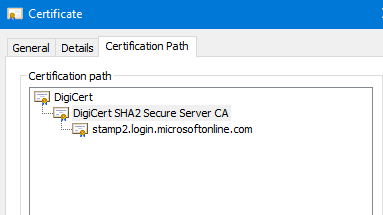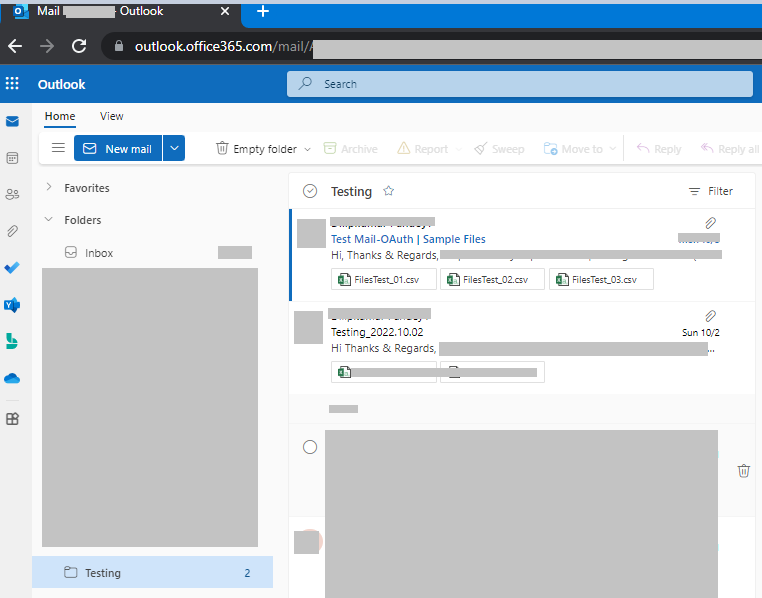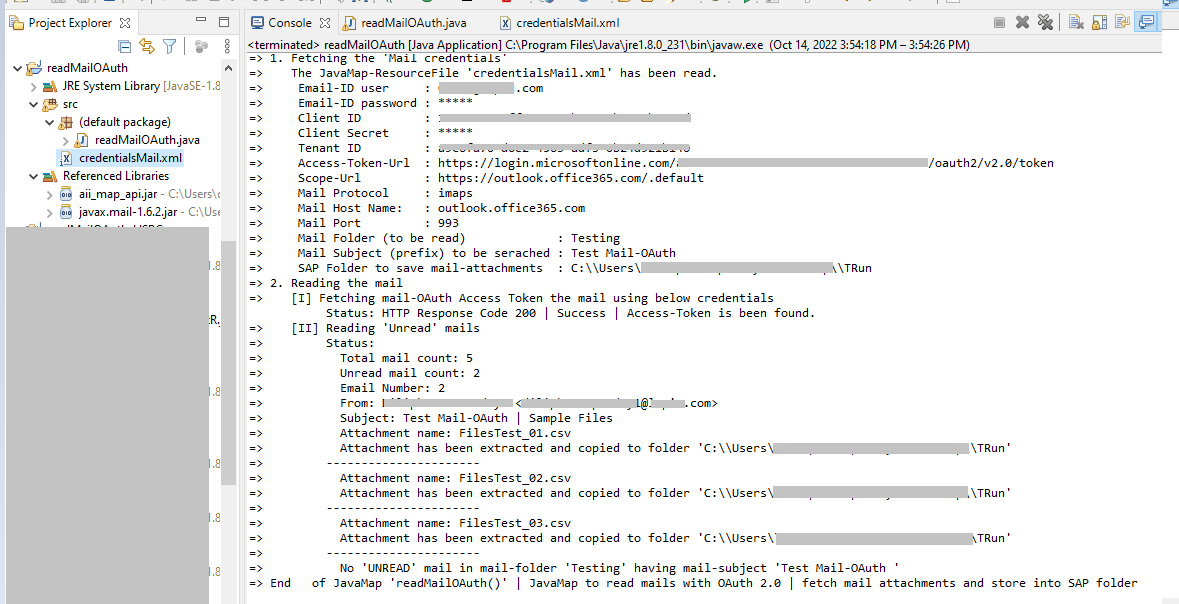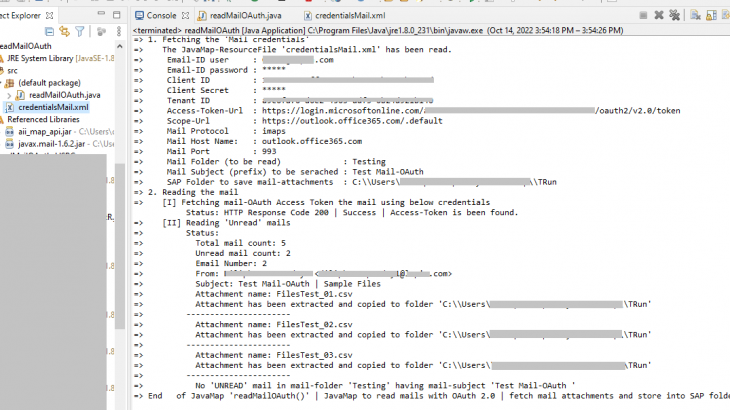Overview:
- Business Requirement: Read mails from a specific mail-folder having specific subject line of a Microsoft outlook mail-account, extract the attachments (.csv files) and store them into local directories.
- Mail OAuth can also be achieved using Mail Adapters “Configure OAuth” Authentication feature.
- This blog gives an overview of an alternative (Java-Map) can be used into the PI/PO interface, where “Mail OAuth 2.0” (access token based) authentication mechanism is been applied.
Pre-requisites:
Following pre-requisites needs to be taken care of:
1. Get specific mail-id’s credentials like Client_ID, Client_Secret, Tenant_ID. For same, below Microsoft Guide link can be referred:
- Authenticate an IMAP, POP or SMTP connection using OAuth
- Quickstart: Register an application with the Microsoft identity platform
2. Understand how to fetch Access-Token using Microsoft-outlook-API protocols as below:
- URL: https://login.microsoftonline.com/<token-ID>/oauth2/v2.0/token
- Method: POST
- Headers: “Content-Type”, “application/x-www-form-urlencoded”
- Request:
- grant_type client_credentials
- client_id <mail-id’s secret value>
- client_secret <mail-id’s secret value>
- scope https://outlook.office365.com/.default
- grant_type client_credentials
grant_type=client_credentials&client_id=<client-ID-value>&client_secret=<client-secret-value>&scope=https://outlook.office365.com/.default
- Response:
{
"token_type": "Bearer",
"expires_in": 3599,
"ext_expires_in": 3599,
"access_token": "<access token value>"
}- Using POSTMAN tool, we can call access-token API as depicted in below screen

- Here, TLS version and Cipher Suite required for this API also needs to be understood, the same should be present in PI/PO layer as well.
3. To allow connection between PI/PO and outlook mail, the Firewall whitelisting rule should be in place having source as PI/PO system and destination having below Microsoft’s FQDN
- login.microsoftonline.com HTTPS-Port 443
- outlook.office.com HTTPS-Port 443
- outlook.office365.com HTTPS-Port 443, IMAP-Port 993, 143, POP3-Port 110, SMTP-Port 25
4. PI/PO system should support/have below:
- TLS Protocol TLSv1.2
- Cipher Suite ECDHE-RSA-AES256-GCM-SHA384 [ in PI/PO ssl.properties having “cipherSuite=TLS_ECDHE_RSA_WITH_AES_256_GCM_SHA384” ]
- SSL ICM parameter at Kernel/OS layer “icm/HTTPS/client_sni_enabled = TRUE”
- In PI/PO, import below SSL certificate chain of ‘https://login.microsoftonline.com’

- Note: While running Java-Map from PI/PO layer, using XPI_INSPECTOR LOG, we can understand in below screen, how SSL handshake takes place between PI/PO and login.microsoftonline.com while fetching the access-token :

Mail OAuth using Java-Map Technique:
- Create a PI/PO interface as asynchronous outbound FILE-to-FILE
- Here, we need to have a dummy file in SAP-Folder. Configure Sender-FILE adapter channel to read this file on an fix poll interval (hourly, daily etc. as per business needs), keep processing mode ‘Test’.
- Configure Receiver-FILE adapter channel to create a dummy file with different name having overwrite feature enabled.
- In ESR, create a SWCP and Namespace with dummy Data & Message Type. Import this Java-Map jar file and utilize into Operation Map.
- In ID, create integration configuration object (ICO), utilize the operation map having Java-Map program.
- Working of this PI/PO interface will be as follows:
- On fix poll interval, say 2 hours, Sender-FILE-CC will keep reading dummy file from sap folder, which interns invokes Java-Map program and post Java-Program logic processing a dummy file will be created using Receiver-FILE-CC having Java-Map logs.
- On fix poll interval, say 2 hours, Sender-FILE-CC will keep reading dummy file from sap folder, which interns invokes Java-Map program and post Java-Program logic processing a dummy file will be created using Receiver-FILE-CC having Java-Map logs.
- The functionalities of Java-Map program is as follows:
- Get Mail-ID’s access token
- Utilize the access-Token in next API, which is to read the unread mails of a specific mail-folder with specific subject-line.
- Note: For reference, this Java-Map also has option about how to perform basic authentication (user-id/password based) to a mail account
- Get Mail-ID’s access token
Contents of the Java map program:
- Jar file ‘aii_map_api.jar’
- Import it in Eclipse but no need to import in PI/PO ‘Enterprise Service Repository (ESR)’
- Import it in Eclipse but no need to import in PI/PO ‘Enterprise Service Repository (ESR)’
- Jar file ‘javax.mail-1.6.2.jar’
- Import it in Eclipse but no need to import in PI/PO ‘ESR’
- Import it in Eclipse but no need to import in PI/PO ‘ESR’
- XML file ‘credentialsMail.xml’
- Import this into Java-Program as resource file | This has mail account credentials (Test / Production both) in below XML structure manner
<?xml version="1.0" encoding="UTF-8"?>
<MailCredentials>
<TEST>
<mail_clientId>***</mail_clientId>
<mail_tenantId>***</mail_tenantId>
<mail_secret>***</mail_secret>
<mail_scopeUrl>https://outlook.office365.com/.default</mail_scopeUrl>
<mail_accessTokenUrl>https://login.microsoftonline.com/(mail_tenantId)/oauth2/v2.0/token</mail_accessTokenUrl>
<mail_protocol>imaps</mail_protocol>
<mail_userEmail>XSD@ASD.com</mail_userEmail>
<mail_userPassword>ASA@ASASFDFD</mail_userPassword>
<mail_host>outlook.office365.com</mail_host>
<mail_port>993</mail_port>
<mail_folderToRead>Testing</mail_folderToRead>
<mail_subjectSerachText>Test Mail-OAuth</mail_subjectSerachText>
<mail_readCountFiletr>20</mail_readCountFiletr>
<mail_sapFolderOut>C:\\Users\\SDA\\TRun</mail_sapFolderOut>
</TEST>
<PRODUCTION>
<mail_clientId>***</mail_clientId>
<mail_tenantId>***</mail_tenantId>
<mail_secret>***</mail_secret>
<mail_scopeUrl>https://outlook.office365.com/.default</mail_scopeUrl>
<mail_accessTokenUrl>https://login.microsoftonline.com/(mail_tenantId)/oauth2/v2.0/token</mail_accessTokenUrl>
<mail_protocol>imaps</mail_protocol>
<mail_userEmail>XSD@ASD.com</mail_userEmail>
<mail_userPassword>ASA@ASASFDFD</mail_userPassword>
<mail_host>outlook.office365.com</mail_host>
<mail_port>993</mail_port>
<mail_folderToRead>Inbox</mail_folderToRead>
<mail_subjectSerachText>REVENUE RPT</mail_subjectSerachText>
<mail_readCountFiletr>20</mail_readCountFiletr>
<mail_sapFolderOut>/FLD1/FLD3/FLD3/FLD4/</mail_sapFolderOut>
</PRODUCTION>
</MailCredentials>4. Jar File ‘readMailOAuth.jar’
- Import this in ‘ESR’ as an ‘Imported Archive’ under desired new interface namespace. | This is the Java-Map jar file, this will be only used in ‘Operation Map’
Java-Map program sample is as below:
This java program’s step wise functionalities are as follows:
- How to read attached resource file (‘credentialsMail.xml’) and as per PI/PO-system-ID instances, how to select the Test or Production credentials.
- How to get access token of ‘Microsoft outlook mail-account’
- How to use access token in next Microsoft API to read unread mails of a specific mail-folder with specific mail-subject line following IMAP protocols.
- How to read only current date’s unread mail
- How to store extracted attachments/files into SAP folder
import java.io.BufferedReader;
import java.io.ByteArrayOutputStream;
import java.io.DataOutputStream;
import java.io.File;
import java.io.FileInputStream;
import java.io.FileOutputStream;
import java.io.FileWriter;
import java.io.IOException;
import java.io.InputStream;
import java.io.InputStreamReader;
import java.io.OutputStream;
import java.io.StringReader;
import java.net.HttpURLConnection;
import java.net.URI;
import java.net.URL;
import java.net.URLConnection;
import java.nio.charset.Charset;
import java.sql.Timestamp;
import java.text.SimpleDateFormat;
import java.time.LocalDateTime;
import java.util.ArrayList;
import java.util.Calendar;
import java.util.Date;
import java.util.HashMap;
import java.util.List;
import java.util.Map;
import java.util.Properties;
import javax.mail.BodyPart;
import javax.mail.Flags;
import javax.mail.Folder;
import javax.mail.Message;
import javax.mail.Multipart;
import javax.mail.Part;
import javax.mail.Session;
import javax.mail.Store;
import javax.mail.internet.MimeBodyPart;
import javax.mail.search.FlagTerm;
import javax.xml.parsers.DocumentBuilder;
import javax.xml.parsers.DocumentBuilderFactory;
import javax.xml.parsers.ParserConfigurationException;
import javax.xml.transform.Transformer;
import javax.xml.transform.TransformerFactory;
import javax.xml.transform.dom.DOMSource;
import javax.xml.transform.stream.StreamResult;
import org.w3c.dom.Document;
import org.w3c.dom.Node;
import org.w3c.dom.NodeList;
import org.xml.sax.InputSource;
import org.xml.sax.SAXException;
import com.sap.aii.mapping.api.AbstractTrace;
import com.sap.aii.mapping.api.StreamTransformation;
import com.sap.aii.mapping.api.StreamTransformationConstants;
import com.sap.aii.mapping.api.StreamTransformationException;
import com.sap.aii.mapping.api.DynamicConfiguration;
import com.sap.aii.mapping.api.DynamicConfigurationKey;
public class readMailOAuth implements StreamTransformation{
private Map param;
public void setParameter(Map map) {
param = map;
if (param == null) {
param = new HashMap();
}
}
private static AbstractTrace trace = null;
private static String mapTrace = "";
public void execute(InputStream in, OutputStream out) throws StreamTransformationException {
try {
mapTrace = "";
mapTrace = mapTrace + "=> Begin of JavaMap 'readMailOAuth()' | JavaMap to read mails with OAuth 2.0 | fetch mail attachments and store into SAP folder" + "\n" ;
mapTrace = mapTrace + "=> 1. Fetching the 'Mail credentials' " + "\n" ;
readRscFile_MailCrd();
mapTrace = mapTrace + "=> 2. Reading the mail " + "\n" ;
readMail();
mapTrace = mapTrace + "=> End of JavaMap 'readMailOAuth()' | JavaMap to read mails with OAuth 2.0 | fetch mail attachments and store into SAP folder" + "\n" ;
String outputXML = "<?xml version=\"1.0\"?>"
+ "<Response>" + "\n"
+ "<JavaMap_Trace><![CDATA[" + mapTrace + "]]></JavaMap_Trace>" + "\n"
+ "</Response>";
Document docOut = convertStringToDocument(outputXML);
TransformerFactory tf = TransformerFactory.newInstance();
Transformer transform = tf.newTransformer();
transform.transform(new DOMSource(docOut), new StreamResult(out));
trace = (AbstractTrace)param.get(StreamTransformationConstants.MAPPING_TRACE);
trace.addInfo(mapTrace);
//System.out.println(mapTrace);
}catch(Exception e){
trace.addInfo("==> Exception in FM execute(): " + e.getMessage());
//System.out.println("==> Exception in FM execute(): " + e.getMessage());
}
}
private void readRscFile_MailCrd() throws IOException, ParserConfigurationException, SAXException{
/**Based on SAPPO-SystemIDs, fetching the TEST or Production Mail-credentials
* Here, XML-Element /MailCredentials/TEST/ stores Test-System Credentials
* and XML-Element /MailCredentials/PRODUCTION/ stores Production-System Credentials
*/
String systemID = "";
try {
//systemID = "DEV"; //For Eclipse-Platform-Testing
systemID = (String) System.getProperty("SAPSYSTEMNAME"); //Get the systemID of PI/PO system (DEV or QAS or PRD)
if(systemID.equals("DEV") || systemID.equals("QAS")){
readRscFile_MailCrd_Elements("TEST");
}
if(systemID.equals("PRD")){
readRscFile_MailCrd_Elements("PRODUCTION");
}
}catch (Exception e) {
mapTrace = mapTrace + "==> Exception in FM 'readRscFile_MailCrd()'==> " + e.getMessage() + "\n";
}
}
private static String mail_clientId;
private static String mail_tenantId;
private static String mail_secret;
private static String mail_scopeUrl;
private static String mail_accessTokenUrl;
private static String mail_protocol;
private static String mail_userEmail;
private static String mail_userPassword;
private static String mail_host;
private static String mail_port;
private static String mail_folderToRead;
private static String mail_subjectSerachText;
private static String mail_readCountFiletr;
private static String mail_sapFolderOut;
private void readRscFile_MailCrd_Elements(String XmlElementTagNm) throws IOException, ParserConfigurationException, SAXException{
//Clear Global variables of this program
mail_clientId = "";
mail_tenantId = "";
mail_secret = "";
mail_scopeUrl = "";
mail_accessTokenUrl = "";
mail_protocol = "";
mail_userEmail = "";
mail_userPassword = "";
mail_host = "";
mail_port = "";
mail_folderToRead = "";
mail_subjectSerachText= "";
mail_readCountFiletr = "";
mail_sapFolderOut = "";
//Read Credentials stored in JavaMap-ResourceFile 'credentialsMail.xml'
String resFileName = "credentialsMail.xml";
//Parse the file into document
DocumentBuilderFactory dbFactory = DocumentBuilderFactory.newInstance();
DocumentBuilder dbBuilder = dbFactory.newDocumentBuilder();
InputStream is_ShpCrd = getClass().getResourceAsStream(resFileName);
Document xmlDocCrd = dbBuilder.parse(is_ShpCrd); //Parse input to create document tree
//----Start: Read Credentials from XmlFile ------
NodeList ndList_shp = xmlDocCrd.getElementsByTagName(XmlElementTagNm);
for(int i1 = 0; i1 < ndList_shp.getLength(); i1++){
Node nd_1 = ndList_shp.item(i1);
for(Node nd_2 = nd_1.getFirstChild(); nd_2 != null; nd_2 = nd_2.getNextSibling()){
if(nd_2.getNodeName().equals("mail_clientId")){
if(nd_2.getFirstChild() != null){
mail_clientId = nd_2.getFirstChild().getNodeValue();
}
}
if(nd_2.getNodeName().equals("mail_tenantId")){
if(nd_2.getFirstChild() != null){
mail_tenantId = nd_2.getFirstChild().getNodeValue();
}
}
if(nd_2.getNodeName().equals("mail_secret")){
if(nd_2.getFirstChild() != null){
mail_secret = nd_2.getFirstChild().getNodeValue();
}
}
if(nd_2.getNodeName().equals("mail_scopeUrl")){
if(nd_2.getFirstChild() != null){
mail_scopeUrl = nd_2.getFirstChild().getNodeValue();
}
}
if(nd_2.getNodeName().equals("mail_accessTokenUrl")){
if(nd_2.getFirstChild() != null){
mail_accessTokenUrl = nd_2.getFirstChild().getNodeValue();
}
}
if(nd_2.getNodeName().equals("mail_protocol")){
if(nd_2.getFirstChild() != null){
mail_protocol = nd_2.getFirstChild().getNodeValue();
}
}
if(nd_2.getNodeName().equals("mail_userEmail")){
if(nd_2.getFirstChild() != null){
mail_userEmail = nd_2.getFirstChild().getNodeValue();
}
}
if(nd_2.getNodeName().equals("mail_userPassword")){
if(nd_2.getFirstChild() != null){
mail_userPassword = nd_2.getFirstChild().getNodeValue();
}
}
if(nd_2.getNodeName().equals("mail_host")){
if(nd_2.getFirstChild() != null){
mail_host = nd_2.getFirstChild().getNodeValue();
}
}
if(nd_2.getNodeName().equals("mail_port")){
if(nd_2.getFirstChild() != null){
mail_port = nd_2.getFirstChild().getNodeValue();
}
}
if(nd_2.getNodeName().equals("mail_folderToRead")){
if(nd_2.getFirstChild() != null){
mail_folderToRead = nd_2.getFirstChild().getNodeValue();
}
}
if(nd_2.getNodeName().equals("mail_subjectSerachText")){
if(nd_2.getFirstChild() != null){
mail_subjectSerachText = nd_2.getFirstChild().getNodeValue();
}
}
if(nd_2.getNodeName().equals("mail_sapFolderOut")){
if(nd_2.getFirstChild() != null){
mail_sapFolderOut = nd_2.getFirstChild().getNodeValue();
}
}
if(nd_2.getNodeName().equals("mail_readCountFiletr")){
if(nd_2.getFirstChild() != null){
mail_readCountFiletr = nd_2.getFirstChild().getNodeValue();
}
}
}
}
//----End : Read Credentials from XmlFile ------
mapTrace = mapTrace + "=> The JavaMap-ResourceFile '"+ resFileName + "' has been read.\n";
mapTrace = mapTrace + "=> Email-ID user : " + mail_userEmail + "\n" ;
mapTrace = mapTrace + "=> Email-ID password : " + "*****" + "\n" ;
mapTrace = mapTrace + "=> Client ID : " + mail_clientId + "\n" ;
mapTrace = mapTrace + "=> Client Secret : " + "*****" + "\n" ;
mapTrace = mapTrace + "=> Tenant ID : " + mail_tenantId + "\n" ;
mapTrace = mapTrace + "=> Access-Token-Url : " + mail_accessTokenUrl + "\n" ;
mapTrace = mapTrace + "=> Scope-Url : " + mail_scopeUrl + "\n" ;
mapTrace = mapTrace + "=> Mail Protocol : " + mail_protocol + "\n";
mapTrace = mapTrace + "=> Mail Host Name: : " + mail_host + "\n";
mapTrace = mapTrace + "=> Mail Port : " + mail_port + "\n";
mapTrace = mapTrace + "=> Mail Folder (to be read) : " + mail_folderToRead + "\n";
mapTrace = mapTrace + "=> Mail Subject (prefix) to be serached : " + mail_subjectSerachText + "\n";
mapTrace = mapTrace + "=> SAP Folder to save mail-attachments : " + mail_sapFolderOut + "\n";
}
private static String getAccessToken () {
mapTrace = mapTrace + "=> [I] Fetching mail-OAuth Access Token the mail using below credentials" + "\n" ;
String accessToken = "";
String httpResponseStr = "";
try {
//Create HttpConenction
URL url = new URL(mail_accessTokenUrl);
URLConnection connection = url.openConnection();
HttpURLConnection httpConn = (HttpURLConnection) connection;
//Set header
httpConn.setRequestProperty("Content-Type", "application/x-www-form-urlencoded");
httpConn.setDoOutput(true);
httpConn.setDoInput(true);
httpConn.setRequestMethod("POST");
//Prepare RequestData
String jsonParam =
"grant_type=" + "client_credentials" +
"&client_id=" + mail_clientId +
"&client_secret=" + mail_secret +
"&scope=" + mail_scopeUrl ;
//Send Request
DataOutputStream wr = new DataOutputStream(httpConn.getOutputStream ());
wr.writeBytes(jsonParam);
wr.flush();
wr.close();
//Read the response
InputStreamReader isr = null;
if (httpConn.getResponseCode() == 200) {
mapTrace = mapTrace +" Status: HTTP Response Code 200 | Success | Access-Token is been found."+ "\n";
//Reading response message
isr = new InputStreamReader(httpConn.getInputStream());
BufferedReader in = new BufferedReader(isr);
String strLine = "";
while ((strLine = in.readLine()) != null) {
httpResponseStr = httpResponseStr + strLine;
}
if (httpResponseStr.indexOf("access_token") > -1) {
accessToken = httpResponseStr.substring((httpResponseStr.indexOf("access_token") + 15), httpResponseStr.lastIndexOf("\""));
//mapTrace = mapTrace +" Response-AccessToken: " + accessToken;
}
} else {
mapTrace = mapTrace +" Response: HTTP code " + httpConn.getResponseCode()+ " Error [" + httpConn.getResponseMessage() +"] while fetching accessToken."+ "\n";
//throwCustomException = throwCustomException + " SharePoint-REST-Exception: AccessToken" + "\n";
}
} catch (Exception e) {
mapTrace = mapTrace + " Exception in FM 'getAccessToken(): " + e.getMessage() + "\n";
//throwCustomException = throwCustomException + " SharePoint-REST-Exception: AccessToken" + "\n";
}
return accessToken;
}
private static void readMail() {
try {
boolean mailFound = false;
// --------------------------------------------------
Properties properties = new Properties();
// Mail-Authentication method: OAUTH 2.0 ===================
properties.put("mail.imaps.auth.plain.disable", "true");
properties.setProperty("mail.imaps.starttls.enable", "true");
properties.setProperty("mail.store.protocol", mail_protocol);
properties.put("mail.imaps.auth.mechanisms", "XOAUTH2");
Session emailSession = Session.getDefaultInstance(properties);
Store store = emailSession.getStore(mail_protocol); // create the store object and connect with the server
String accessToken = getAccessToken();
store.connect(mail_host, Integer.parseInt(mail_port), mail_userEmail, accessToken);
// =========================================================
/*
// Mail-Authentication method: Plain/Basic =================
properties.put("mail.imaps.host", mail_host);
properties.put("mail.imaps.port", mail_port);
properties.put("mail.imaps.starttls.enable", "javax.net.ssl.SSLSocketFactory");
properties.put("mail.imap.fetchsize", "1000000");
Session emailSession = Session.getDefaultInstance(properties);
Store store = emailSession.getStore(mail_protocol); // create the store object and connect with the server
store.connect(mail_host, mail_userEmail, mail_userPassword);
// =========================================================
*/
// create the folder object and open it
Folder emailFolder = store.getFolder(mail_folderToRead);
// emailFolder.open(Folder.READ_ONLY);
emailFolder.open(Folder.READ_WRITE); // makes 'read' state to mail once it's been read by program
// Read the mails of a specific folder
// Message[] messages = emailFolder.getMessages(); //Reads all mails of a folder
Message messages[] = emailFolder.search(new FlagTerm(new Flags(Flags.Flag.SEEN), false)); // Reads only 'Unread' mails
mapTrace = mapTrace + "=> [II] Reading 'Unread' mails" + "\n";
mapTrace = mapTrace + "=> Status: " + "\n";
mapTrace = mapTrace + "=> Total mail count: " + emailFolder.getMessageCount() + "\n";
mapTrace = mapTrace + "=> Unread mail count: " + emailFolder.getUnreadMessageCount() + "\n";
/*
//Get current Date-Time
LocalDateTime now = LocalDateTime.now();
int year = now.getYear();
int month = now.getMonthValue();
int day = now.getDayOfMonth();
*/
int mailReadLimit = Integer.parseInt(mail_readCountFiletr.trim());
int mailReadCount = 0;
for (int i = messages.length - 1; i >= 0; i--) {
Message message = messages[i];
/*
//Filter only current date's mail only
Calendar cal = Calendar.getInstance();
cal.setTime(message.getReceivedDate());
int yearMessage = cal.get(Calendar.YEAR);
int monthMessage = cal.get(Calendar.MONTH) + 1;
int dayMessage = cal.get(Calendar.DAY_OF_MONTH);
if(year == yearMessage && month == monthMessage && day == dayMessage) {
*/
// To read specific Mail-subject mails
String mailSub = message.getSubject().toString();
//if (mailSub.startsWith(mail_subjectSerachText) && mailFound != true) {
if ((mailSub.indexOf(mail_subjectSerachText) > -1)) {
mapTrace = mapTrace + "=> Email Number: " + (i + 1) + "\n";
mapTrace = mapTrace + "=> From: " + message.getFrom()[0] + "\n";
mapTrace = mapTrace + "=> Subject: " + mailSub + "\n";
Multipart multipart = (Multipart) message.getContent();
// Read all unread mails having given Mail-Subjects
for (int j = 0; j < multipart.getCount(); j++) {
MimeBodyPart bodyPart = (MimeBodyPart) multipart.getBodyPart(j);
if (Part.ATTACHMENT.equalsIgnoreCase(bodyPart.getDisposition())) {
/**
* AttachName is present into bodyPart.Type =>
* "application/octet-stream; \r\n name=TestFileName_25011998155508.csv"
*/
String attachmentName = bodyPart.getContentType().toString();
attachmentName = attachmentName.substring(attachmentName.indexOf("name=") + 5);
bodyPart.saveFile(mail_sapFolderOut + attachmentName); // save the attachment to folder
mapTrace = mapTrace + "=> Attachment name: " + attachmentName + "\n" ;
mapTrace = mapTrace + "=> Attachment has been extracted and copied to folder '" + mail_sapFolderOut + "'\n" ;
mapTrace = mapTrace + "=> ----------------------" + "\n" ;
}
}
} else {
mapTrace = mapTrace + "=> No 'UNREAD' mail in mail-folder '" + mail_folderToRead + "' having mail-subject '"+ mail_subjectSerachText + "'\n" ;
}
//}//current date mail filter
//limit mail read count
mailReadCount = mailReadCount + 1;
if (mailReadCount >= mailReadLimit) {
break;
}
}//end of mail-folder visit
// close the store and folder objects
emailFolder.close(false);
store.close();
} catch (Exception e) {
mapTrace = mapTrace + "=> Exception in readMail() | " + e.getMessage() + "\n" ;
}
}
private static Document convertStringToDocument(String xmlStr) {
DocumentBuilderFactory factory = DocumentBuilderFactory.newInstance();
DocumentBuilder builder;
try
{
builder = factory.newDocumentBuilder();
Document doc = builder.parse( new InputSource( new StringReader( xmlStr ) ) );
return doc;
} catch (Exception e) {
e.printStackTrace();
}
return null;
}
/*
public static void main(String[] args) {
try {
String filePath = "C:\\Users\\xyz\\";
String Fnm = "Test_01.txt";
String inputFile = filePath + Fnm;
String outputFile = filePath + "OP_" + Fnm + ".xml" ;
readMailOAuth myClass = new readMailOAuth();
FileInputStream in = new FileInputStream(inputFile);
FileOutputStream out = new FileOutputStream(outputFile);
myClass.execute(in, out);
}catch(Exception e){
e.printStackTrace();
}
}
*/
}Testing:
For reference, test screen samples are give as follows:
Mail-Account having few unread mails. But Java-Program will checking mail-folder ‘Testing’ and filters unread mails having subject line ‘Test Mail-OAuth’

Below Eclipse’ CONSOLE message log gives impression on step wise functionalities:











